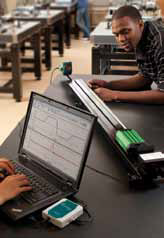Vernier Logger Pro and Go!Motion Sensor
By Ken Roberts
Posted on 2013-01-25
It’s hard to write a review for Vernier’s motion sensor and not sound like I’m writing an advertisement. Between the interface to the software and number of possible applications, this is one of the most modular and versatile tools of scientific investigation a physics teacher is likely to encounter. Let’s start with the hardware. Unlike previous and different companies’ motion sensors, this one plugs in using the same USB cable your printer or scanner might use. That makes storage much easier, while it also means if I (or a student) manage to damage or misplace the cable, replacements are both cheap and plentiful. Thanks for going generic, Vernier! Now let’s talk applications. If you’re reading this, you’re probably a physics teacher, and you’re likely at some point to use a motion sensor like this to follow a cart, ball, or other object. Let me tell you, the Go!Motion sensor delivers. To measure the efficiency of a motor reeling in a vertically suspended shoe box, I used the motion sensor looking up at the shoe box from the floor. Worked perfectly. Same for a basketball dropped from under the motion sensor looking down. Same for a student carrying a whiteboard in a graph-matching exercise. It just works. In fact, I tried replacing my old photogate with the Go!Motion sensor to analyze the pendulum’s motion. Worked even better! I must admit a large par t of what makes the Go!Motion sensor a great piece of lab equipment is the software. Logger Pro is intuitive, straightforward, and inexpensive. For a typical pendulum experiment , I had previously had used a photogate to just measure the pendulum’s periods and average them over each trial. Using the Go!Motion sensor, I just placed it on a lab table, aimed it horizontally at the pendulum, and the sensor watched as the pendulumm approached and receded. Now it just became that much easier to teach simple harmonic motion, since I have demonstrable evidence that the motion of both the pendulum and a mass suspended from a spring are sinusoidal. And with the Curve Fit tool, I can fit a sine curve to my pendulum’s posi t ion-versus- t ime graph, get the period, and get the correlation so I know how confident I should be in the value. What could be easier? Putting it all together, if you want a device that just works for you, no questions asked, I would strongly recommend the Go!Motion sensor from Vernier. It’s great as a stand-alone product because of its USB functionality, but will also be backwards compatible if you do have older Vernier hardware on hand. Logger Pro allows students and teachers to have a very straightforward analysis of the data you collect in lab. It’s a lot of bang for the buck, and a site license costs as much as do many companies’ single-user licenses. Not only that, but when you call tech support, you might even be speaking with Dave Vernier himself.
Disclaimer: The views expressed in this blog post are those of the author(s) and do not necessarily reflect the official position of the National Science Teaching Association (NSTA).


